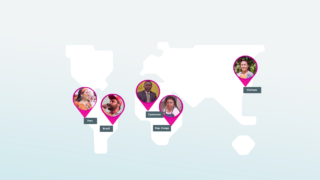
Forest Voices: The path forward for strengthening forest governance
In the five chapters of our Forest Voices series, interviewees from around the world, who are committed to protecting forests, share their experiences of combating illegal logging, restoring land and supporting forest communities. Here, we take a look back at their stories and consider how their insights can guide policy decisions at COP26 and beyond.
To address the climate crisis and loss of biodiversity, protecting the world’s forests is crucial. Forests play a critical role in absorbing carbon dioxide and regulating the weather, and unless enough biodiverse, tree-rich and forested landscapes are maintained, dropping emissions to the required level is near impossible.
This has been widely recognized by governments and numerous commitments have been made over the years to plant trees, halt deforestation and protect forests. However, as is clear from the latest report from the New York Declaration on Forests Assessment, progress to date is far behind the necessary targets.
With societies, livelihoods and the natural world at stake, global leaders at COP26 must commit to ambitious policies for forests to ensure global warming stays under 1.5°C – but these will need to go beyond headline targets.
The policies countries enact must put forest dependent communities, particularly indigenous peoples, at their centre. Their participation is of critical importance not just to help ensure more equitable outcomes but also to increase the chances of success.
The five chapters of our Forest Voices series, highlighting the perspectives of those working alongside forest communities in Cameroon, Brazil, Vietnam, the Republic of the Congo and Peru, articulate how strengthening forest governance can both support sustainable rural livelihoods and protect forests.
While they may be geographically distinct, the interviewees’ perspectives on what needs to be done overlap in several ways. We hear about the transformative potential of participatory legal reform, the benefits of empowering forest communities to manage their resources and the power of independent forest monitoring.
The lessons learned from these chapters form an urgent call for governments and leaders at COP26, and beyond, to devise a plan for tackling climate change that champions the needs of forests and forest communities around the world.
One priority that the Forest Voices series highlights is the need for countries to have in place robust legal frameworks that take into account the different priorities of everyone involved in forest governance, in particular, those of forest-dependent communities.
Countries can look to the Republic of the Congo’s new Forest Code for participatory methods of legal reform. The code’s content was devised over years of negotiation between civil society organizations, the private sector and the government, and the high level of support for the outcomes of this process among these different stakeholders, testifies to the benefits of giving everyone a seat at the table.
Inès Mvoukani, a legal analyst who helped civil society organizations during the process of negotiating the code, believes its biggest achievement is enshrining the rights of forest communities into law through the principle of free, prior and informed consent (FPIC). In practice, this means that whenever an action is proposed that would affect forest communities, they must be asked for their consent.
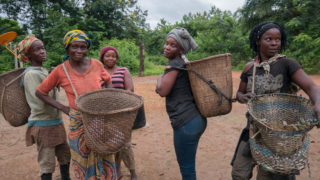
Image - Women collecting forest products in the Republic of the Congo
The fight for FPIC and land rights is also being led by indigenous peoples in Peru where evidence shows that forests managed by indigenous communities are more likely to be protected from deforestation than their state-run counterparts.
However, around 24 million acres of indigenous peoples’ customary land isn’t recognized under Peruvian law, making it vulnerable to seizure by the government or industry.
Women are disproportionately affected by this struggle for land rights with their lack of representation in legal processes one factor for this inequality. According to a 2019 survey, 43 per cent of men in Peru’s indigenous communities take part in community rule-making activities, compared to 22 per cent of women. Because of this, women’s particular needs are often not taken into account.
Peru’s National Organization of Indigenous Andean and Amazonian Women (ONAMIAP) has been addressing this through working with indigenous communities to find ways for them to adopt more equitable governance structures. At the same time, it is providing training and support for women to enable them to advocate more effectively for their rights, not just at the community level, but also nationally.
‘As women, we are the most affected when the land is taken from us,’ says Ketty Marcelo Lopez, a campaigner with ONAMIAP. ‘Women’s voices are often not heard so we are fighting to give women a voice.’
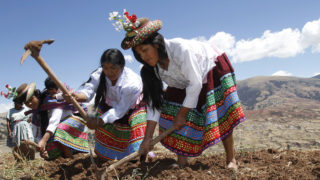
Image - Indigenous Peruvian women farming the land
In the Republic of the Congo, inclusivity was achieved by extensive dialogue between forest communities and civil society organizations who were committed to ensuring that the new laws benefitted all who live in the forests.
‘We listened to the problems that they were facing and their needs were transformed into priorities,’ says Inès
To scale up this work and ensure that more communities have a voice and regain control of their futures, governments and the international community need to work alongside civil society and devote substantially more resources in support of communities for their training.
The Forest Voices series illustrates the critical importance of forests in supporting the livelihoods of communities around the world – and how the climate crisis is currently impacting this.
Policies that enable communities to establish or maintain sustainable livelihoods are crucial. As many of the interviewees point out, if communities are allowed to thrive on their own land, this is conducive to the sustainable management of forest resources. And, fundamental to achieving this, is the legal recognition of land rights and the implementation of FPIC as highlighted in the case of Peru.
Ensuring that communities are engaged more broadly in decisions about land is also critical. ‘The true guardians of biodiversity and nature are the people that live on the land, from the land and for the land,’ says Silvio Netto, an organizer in Brazil’s Landless Workers Movement (MST).
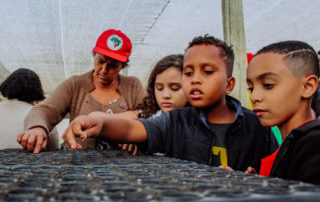
Image - Young participants learn agroforestry techniques in a seedling nursery
The MST’s tree planting and agroforestry initiatives in the state of Minas Gerais have helped to restore lands that were severely damaged by mining operations. Although there remains a long way to go, the restoration efforts to date are not only helping to revitalize communities’ livelihoods, but are also making the land more resilient to future climate change.
‘It's not only a cultural and spiritual approach, it's also a fact that the restored and balanced environment allows us to produce good and plentiful food,’ says Silvio.
In Vietnam, the coffee industry is destroying the country’s forests to keep up with demand, but smallholder Trieu Thi Chau shares Silvio’s belief in rural peoples’ ability to protect the land.
'In my community, we are very well aware of the importance of nature. We are careful with the environment. We don’t chop down woodland and we respect the boundary between the farm and the forest,' says Chau.
Agriculture is driving deforestation around the world with crops such as coffee, soya beans, cocoa and palm oil – known as forest risk commodities – accounting for much of the problem. Indeed, around 60 per cent of tropical forest loss between 2013 and 2019 was driven by the production of agricultural commodities.
Legislation on agricultural supply chains could help to protect the world’s forests – and a number of countries are developing such laws – but any legislation must consider those who depend on farming to earn a living.
Governments in consumer countries should also engage with all stakeholders in the supply chains and ensure that laws are appropriate to the rural economies where the crops are being grown.
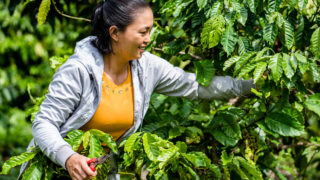
Image - Chau a farmer tends to the coffee crops on her farm in Dak Lak province
Many smallholders face challenges in complying with regulations around deforestation and sustainable land management. 'We need support from experts, telling us how to improve current practices and we need to understand that there are techniques that ensure the environment can be improved without reducing smallholders’ profits,’ says Chau.
Besides training and technical assistance, financial support also needs to be provided to smallholders if sustainable agroforestry and farming are to become the norm.
A final priority that the Forest Voices series highlights is the power of forest communities in combating illegal logging and deforestation as these communities are well placed to monitor activities in the forests near where they live.
In Cameroon, for example, Rodrigue Ngonzo of FODER explains how independent forest monitoring (IFM) enables rural people to protect their rights by using real-time monitoring software to provide governments and civil society organizations with instant updates on illegal activities in the forest.
Civil society organizations have a central role in training forest communities in using the software as well as in compiling and validating reports of infractions before these are sent to the country’s forest ministry. In this way, independent monitoring acts as an extension of official law enforcement agencies who often lack the resources to travel to remote parts of the country

Image - A group of community forest monitors learn how to use the real time alert system Forest Link
While it has already resulted in a number of enforcement actions in Cameroon, Rodrigue explains that giving legal recognition to IFM could enable it to have a bigger role – a step recently taken by the Republic of the Congo in its new forest code. This official recognition – whether in national or in international laws – can help ensure that IFM has the necessary legitimacy and influence.
However, greater understanding of the benefits of working with civil society is still needed amongst policymakers.
‘They need to be aware that without strong civil society organizations, and without strong independent monitors on the ground, the objective of reducing deforestation and forest degradation might not be achieved,’ says Rodrigue.
This approach could be used for monitoring compliance, not just in the forest sector, but also in other land-use sectors. Furthermore, it could be valuable in monitoring the implementation of countries’ climate strategies and commitments by providing an additional source of feedback and oversight both for national governments and the international community.
However, to fulfil its potential role, adequate training and resources must be designated. One important aspect of this should be to increase awareness among forest communities of the law and of their legal rights to enable them to properly hold governments and industry to account.
‘The law must be known to everybody so every one of us can react when faced with inequalities,’ says Inès.
The 2021 IPCC report highlights the urgency of reducing greenhouse gas emissions, calling for immediate action if the world is to moderate the worst effects of climate change.
Recent extreme weather events and forest fires globally highlight the risks of inaction and harnessing the potential of forests to mitigate and adapt to climate change has never been more important.
At COP26, ambitious commitments on forests are needed from governments both in their nationally determined contributions (NDCs) and long-term strategies for climate action while the financial resources to support these commitments also need to be made available.
But, while targets for financing and protecting forests are important, achieving them will require establishing processes and mechanisms in which forest communities’ needs and priorities are at the centre.
Furthermore, robust monitoring frameworks will be needed to report on, and monitor the impacts of, these pledges. This will be facilitated by the establishment of common timeframes for NDCs so that progress can be accurately gauged – an issue that should be resolved at COP26.
Finally, a sound framework for monitoring, not just the climate impacts, but also the social and economic impacts of climate actions must be developed.
Protecting the world from the worst effects of climate change starts with defending forests and those people dependent on them. What happens at COP26 will be key to how quickly and effectively we respond to this challenge.
Ambitious targets on forests are essential at COP26 if the world is to mitigate the worst impacts of climate change and transition to more sustainable and resilient land-use systems. Outcomes at the conference should include:
- Recognition of forests as a priority within countries’ NDCs and long-term development strategies.
- Commitment of substantial finance to support action on forests. Mechanisms need to be established to ensure its accessibility to a range of stakeholders, particularly the most marginalized groups.
- Agreement on a common timeframe for NDCs.
- Formal recognition of the role of civil society in monitoring countries’ climate actions.
Looking beyond COP26, the achievement of these targets will require a step-change in forest governance. A shift towards more inclusive and participatory approaches is needed which will require the following actions:
Strengthening of participatory law-making so that the needs and priorities of all stakeholders are reflected in the law. This will require:
- Governments to be more open and provide the mechanisms to enable civil society to contribute to, and shape, policies.
- Governments and the international community to provide training for civil society. This must target the most marginalized – including indigenous peoples and women – to ensure their inclusion.
Ensuring laws and regulations strengthen the livelihoods of rural people and enable them to be partners in the governance of land and forests. This will require:
- Governments to legislate for, and implement, the principle of FPIC and to recognize the land rights of indigenous peoples.
- Governments of those countries considering regulations to tackle deforestation in agricultural commodity supply chains to consult with all stakeholders to ensure any measures adopted are appropriate to the rural economies where the crops are being grown.
- Governments and the international community to prioritize training, technical assistance and financial support to smallholders.
Enabling forest-dependent communities, including indigenous peoples, to monitor forests both to help control illegal activities and to assess the effectiveness of climate actions. This will require:
- National and international policymakers to formally recognize the role of independent monitors as a source of evidence and information.
- Governments and the international community to provide technical support and finance for independent monitoring.
--------------------------------------------------------------------------------------------------
About the series
This new set of stories aims to draw attention to the critical importance of good forest governance for achieving global commitments on biodiversity, climate change and poverty eradication. Through personal perspectives on a variety of approaches from around the world, the series seeks to highlight some of the lessons learned so far and what further action will be needed at the UN’s COP26 climate conference in November 2021 and beyond.
--------------------------------------------------------------------------------------------------
Produced by Unfold Stories.
Written by Molly Millar. Graphics by Alex Sommers. Production by James Lovage.
The views expressed in this article are those of the experts interviewed and not of Chatham House.